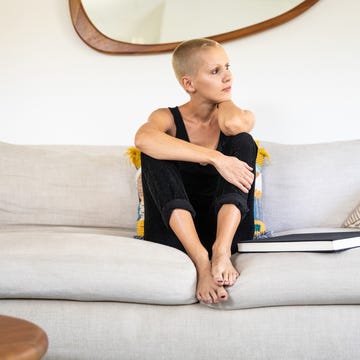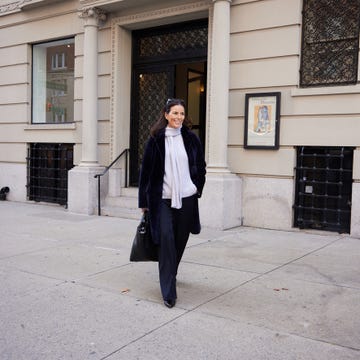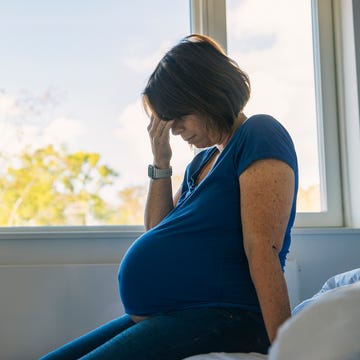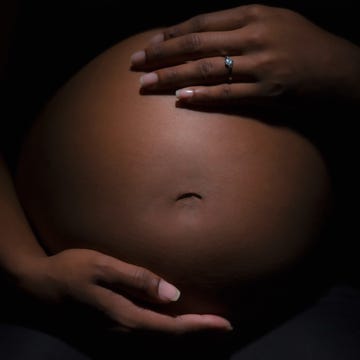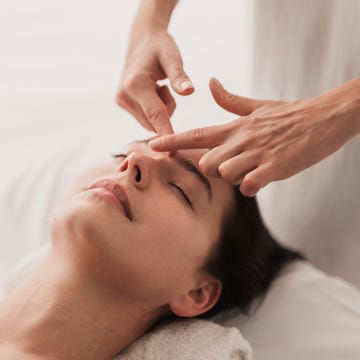“How do you feel about your period?” The question, posed by my neurologist as she dutifully explored new ways to treat my migraines, sent me down a shame spiral that landed me in the early ’90s. My period debuted when I was in the seventh grade, and made quick work of turning my favorite pair of jeans into a crimson-hued Rorschach test. I spent the rest of my first day as a woman wearing my PE uniform from the waist down and learning the true meaning of shame. In high school, I feared my heavy flow so intensely that I never left the house without a backpack full of maxi-pads so large they could double as water skis. By the time I was in college, brutal cramps, intense back spasms, and cold sweats ushered in my biblically heavy period each month. My roommates took turns handing in my assignments whenever I was too ill to go to class, and I leaned into my professors’ assumptions that I was just another hungover college girl. The truth, somehow, felt worse.
By my midthirties, migraines became the checkered flag that signaled the arrival of my period. And while medication helped lessen my migraines’ frequency and severity, there was still one particularly paralyzing headache that always showed up on race day. “It’s my Waterloo,” I whined in response to the doctor’s question. To my surprise, she responded by asking if I’d feel comfortable just eliminating my period and, hopefully, the migraines that came with it. “I can do that?” I asked in the excited pitch usually reserved for children opening Christmas presents or the recently engaged. “You can do that,” she replied, setting aside a prescription pad. “It’s not that hard.”
Addressing period elimination (or “menstrual suppression”) is impossible to do without wading into the mysteriously murky waters of hormonal birth control, some forms of which (the Pill, patch, and ring) remain the most effective medications for regulating periods and their side effects. Birth control provides the body with synthetic versions of progesterone and estrogen, the ovarian hormones released when the body is pregnant (typically swapping in progestin and estradiol). Think of progesterone and estrogen as the bouncer and clipboard-wielding doorman for Club Uterus, working together to keep the ovaries from releasing any new eggs and strengthening the endometrium so that errant sperm never make it inside. When an egg is not fertilized, the bouncer and doorman go off duty, causing the drop in progesterone and estrogen that leads to the uterine lining shedding (your period). Avoiding that hormonal dip by taking continuous birth control is the key to turning off your period, and could provide a significant degree of relief for women suffering from conditions as wide-ranging as asthma, rheumatoid arthritis, endometriosis, diabetes, polycystic ovary syndrome, anemia, seizure disorders, and depression, among other mental health issues. Women with physical and developmental disabilities who have difficulty coping with the hygienic requirements of a period, or who may be dependent on others for care, have had the option of suppressing their periods for decades with no record of sustained physical side effects. So why is it not more common for women dealing with other physical and mental hardships? Or those of us who simply can’t take it anymore?
“If you’re not trying to make an embryo, there’s no point to bleeding,” says Sophia Yen, MD, CEO and cofounder of Pandia Health. “This incessant menstruation is a modern construct.” It is indeed only in the last 100 years (and ironically, with the advent of birth control) that women have come to experience an estimated 350 to 400 periods in their lifetime. As contraceptive pioneers Elsimar M. Coutinho, MD, PhD, and Sheldon J. Segal noted in their book Is Menstruation Obsolete?: “As recently as colonial times...women had an average of eight children, with long periods of lactation between frequent pregnancies.” Putting that into clearer context, Yen asks, “How many periods do you have when you’re pregnant? Zero. How many periods do you have when you’re exclusively breastfeeding? Zero.” Prior to the industrial revolution, a woman may have only experienced perhaps 100 periods, because she was typically either pregnant or breastfeeding for the majority of her fertile years. “Relatively speaking,” write Coutinho and Segal, “the colonists were menstruation-free compared to their descendent daughters just a few generations later, who average fewer than two children.”
If history has given us the precedent for eliminating periods, science is now backing it up with evidence that it’s actually beneficial, because the less frequently we menstruate, the lower our chances are of developing reproductive cancers. So, “why are we building and sloughing, building and sloughing? Every time we build, we risk endometrial cancer,” Yen says. “Every time we pop out an egg, we’re risking ovarian cancer. And why are we doing this for 10 [to] 20 years pre-baby, and then another 10 to 20 years post-babies—if we’re not trying to make a baby?”
Even John Rock, Gregory Pincus, and Min-Chueh Chang, architects of the modern birth control pill, acknowledged in 1958 that a woman could presumably create a menstrual cycle of her own desired length while on the Pill, yet they chose to introduce the idea of a hormone-free “placebo” week to their birth control cycle, believing that women would be reassured by the arrival of their period. Rock, a devout seven-days-a-week Catholic, hoped that by preserving menses he could finally obtain the Catholic Church’s approval of the Pill, arguing that married couples could still partake in church-sanctioned “natural” birth control practices like the rhythm method by using a woman’s cycle as their guide. But in 1968, eight years after the Pill was first approved by the FDA (and four years before it would finally be legal for use in all 50 states, regardless of marital status), Pope Paul VI declared that all “artificial” methods of contraception, including the Pill, were against the church’s values. Despite other improvements over six decades, the 28-day cycle with a placebo week remains the template for most iterations of the Pill, leaving the church’s fingerprints all over the medication it continues to reject more than 60 years later (despite its potential to minimize pain and suffering).
For Yen, who specializes in adolescent medicine, turning off your period has another upside: It gives women and girls a greater opportunity to succeed where they may otherwise be held back. “I ask any mother or parent of anybody with a uterus, ‘Is your young person going to do better on finals bleeding or not bleeding? At soccer, bleeding or not bleeding? At her Olympic swim meet, bleeding or not bleeding?’ ” she says. “It’s about competitiveness. It’s about equality.” The gender divide does appear to fork around the time that periods come into play. “Starting at puberty, boys and girls start to separate in terms of their mental health experience,” says reproductive psychiatrist Uma Lerner, MD. “Girls and women have higher incidences of depression and anxiety, and all of that really begins with puberty, which shows that women’s hormones and repression of hormones make a big difference in our mental health.” These early experiences can have a lasting impact. When I had my debilitating periods, I often skipped parties and other opportunities to socialize with my peers (to say nothing of missed classes and the constant fear I harbored of accidentally unleashing a flotilla of maxi-pads while pulling out a schoolbook). “So much is missing when we talk about girls’ academics compared to boys’, and STEM and STEAM classes and girls’ confidence rates, but we don’t account for the fact that girls are dealing with a lot of physical issues that [are still enshrouded in] stigma,” Lerner adds.
There has been some progress toward normalizing period elimination, with the emergence of safe, long-acting reversible contraceptives (LARCs) like IUDs and implants. By providing a steady stream of hormones, these eliminate periods in up to 50 percent of users; the remainder typically see lighter and less frequent periods. Despite confirmation by the American College of Obstetricians and Gynecologists (ACOG) that LARCs are “the most effective reversible contraceptives and have an excellent safety record,” studies have shown that while most ob-gyns do offer IUDs, they often exclude some appropriate candidates, namely women who have not given birth. This is particularly surprising given that ACOG recommends IUDs as the “first-line contraceptive choice” for those very women. A 2012 study of health care providers conducted by ACOG found that 30 percent of respondents had outdated misconceptions about the safety of IUDs, mistakenly perceiving them to be unsafe or very unsafe, or stating that they were “unsure” (that is, they “did not know if IUDs were safe”), for women who have not given birth. The study concluded that “additional training and health care provider education are critical to reduce health care provider biases and to potentially increase the provision of IUDs.”
Incredibly, one study showed that nearly 42 percent of female family planning health providers themselves use some form of LARC, a statistic that clearly supports the safety and efficacy of the IUD in particular and LARCs in general. It’s important to note that a nonhormonal LARC—the copper IUD—does exist, and is generally the best option for women with hormone sensitivities (most notably breast cancer and blood clotting issues). It does not, however, aid in suppressing menstruation, and it takes an informed physician to help you navigate finding a safe, appropriate match regardless of your circumstances. So while your doctor may continue to ask the date of your “last menstrual period” on every visit, it’s still unlikely that eliminating your period will play an immediate role in treating whatever ails you, unless you broach the subject yourself.
In my case, it took three years of migraine treatment before my doctor even mentioned the possibility of eliminating my period. It was only brought up after I’d tried multiple medications, altered my diet, taken supplements, gotten vitamin injections, taken thrice-yearly blood tests, and begun keeping a weather journal. It would be another two years of experimenting with birth control options and going head-to-head with my period before I started to feel better. And while my neurologist is still diligently working to one day make me 100 percent migraine-free, I’m happy to report that my life’s biggest headache—my period—is finally in my rearview.
Learn More:
This article originally appeared in the April 2021 issue.



